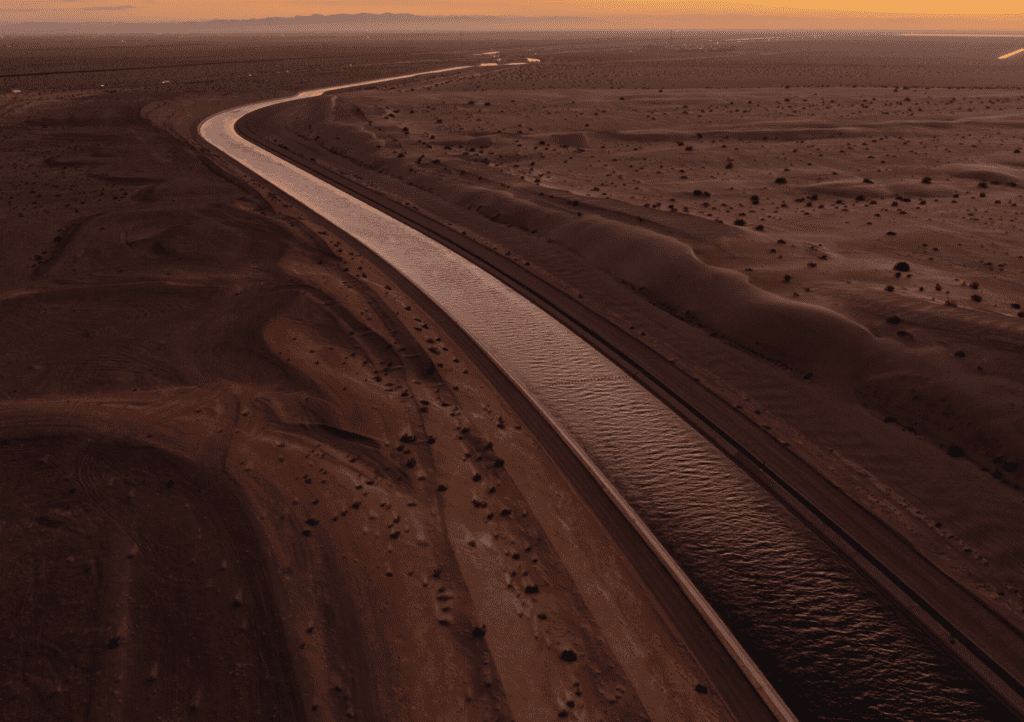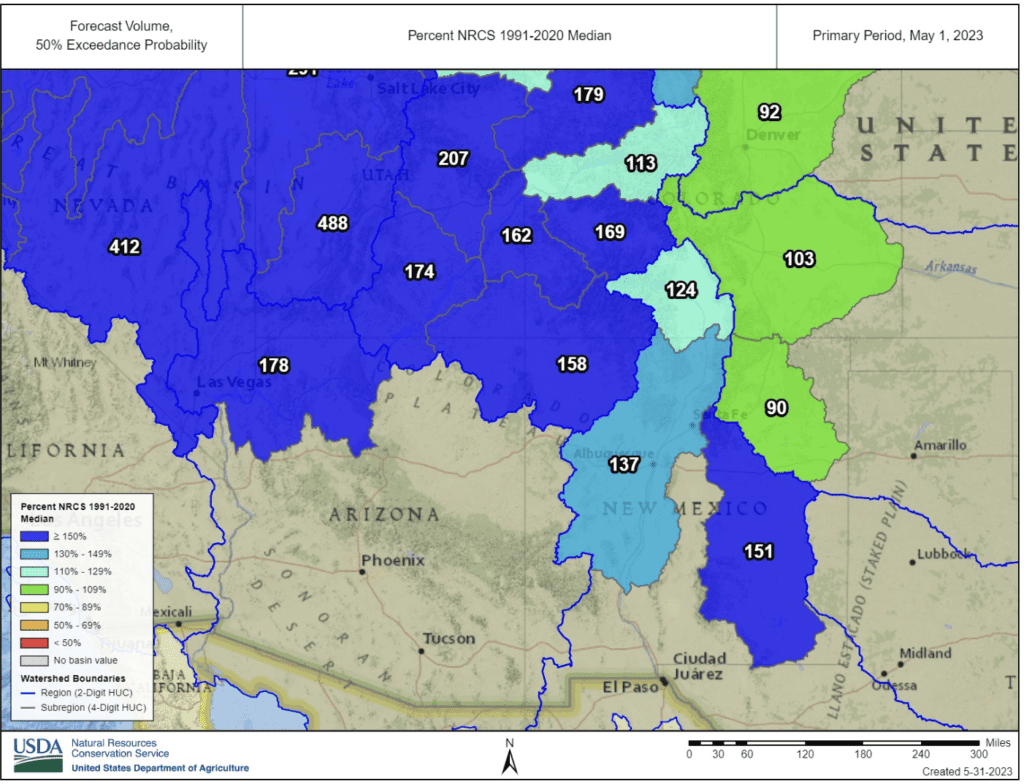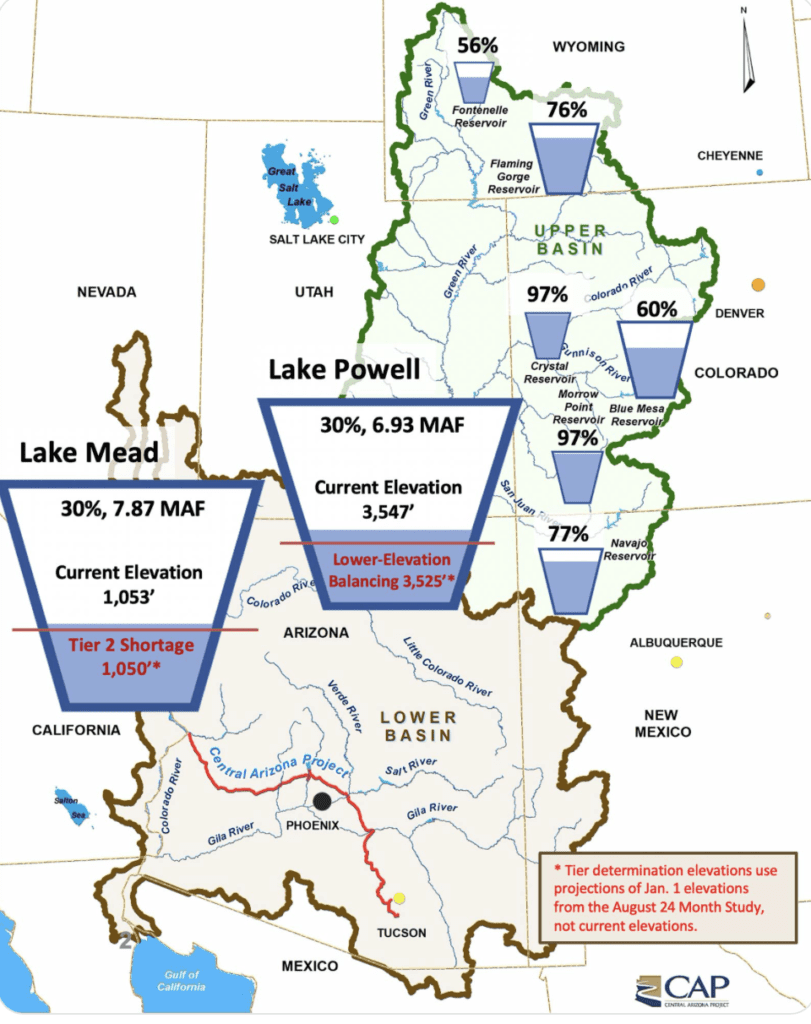Daniel Salzler No. 1207
EnviroInsight.org Two Items June 23, 2023
—————Feel Free To Pass This Along To Others——————
If your watershed is doing something you would like others to know about, or you know
of something others can benefit from, let me know and I will place it in this Information .
If you want to be removed from the distribution list, please let me know.
Please note that all meetings listed are open.
Enhance your viewing by downloading the pdf file to view photos, etc.
The attached is all about improving life in the watershed.
If you want to be removed from the distribution list,
please let me know. Please note that all meetings listed are open.
Check our website at EnviroInsight.org
- As the Colorado River Declines, Water Scarcity and the Hunt for New Sources Drive up Rates
The price of water is rising across the Southwest as utilities look to cover the cost of the increasingly scarce resource, the infrastructure to treat and distribute it and the search for new supplies.

PHOENIX—Across the Southwest, water users are preparing for a future with a lot less water as the region looks to confront steep cuts from the Colorado River and states are forced to limit use to save the river. Farms are being paid to not farm. Cities are looking to be more efficient and find new water supplies. And prices are starting to go up.
In Phoenix, the city’s Water Services Department is preparing to increase residents’ monthly water bills starting this October if the hike is approved by the city council. The city isn’t alone. Water providers throughout the entire Colorado River Basin have raised water rates, or are preparing to, to compensate for increasing costs of infrastructure repairs and water shortages along the river. Inflation is driving up the costs of resources to treat and deliver water to customers, and other additional fees are planned to incentivize conservation.
The issue is economics 101, said Casey Wichman, an assistant economics professor at Georgia Institute of Technology and a university fellow with Resources for the Future who studies water pricing. Providers along the basin are coming to terms with the diminishing supply in the river and the infrastructure that needs to be repaired or replaced, largely driven by the rapid growth in population. All of those drive up costs, he said.
“The cheapest way to build new supply is just to get your customers to use less.” To do that, he said, water utilities often turn to raising rates, making the need to incentivize conservation another driver of the increasing price of water.

Finding new water sources and getting people to conserve more is becoming increasingly important as the Southwest grapples with climate change and looks to shore up its supply.
The region has experienced more than 20 years of drought and decades of overallocation. Arizona’s supply from the Colorado River has already been extensively cut back, and under a proposal from the river’s Lower Basin states introduced last month and supported by the Biden Administration, the states would agree to cut an additional 3 million acre feet of water over the next three years to prevent Lake Mead and Lake Powell, the nation’s two largest reservoirs, from falling to levels that wouldn’t allow electricity generation at the Hoover and Glen Canyon dams, or the river stops flowing past the dams altogether.
In recent years the Central Arizona Project, a 336-mile-long system that delivers Arizona’s allocation of Colorado River water to around 80 percent of the state’s population, has seen a nearly 25 percent cut in the amount of water that flows through its canal.
“We’re spreading that cost over fewer acre feet. It’s really just that simple,” he said. “It doesn’t have anything to do with us having to do any major retrofits to accommodate less deliveries or change our business operations in a meaningful way. It’s just less water.”
This year, the cost of an acre foot of water, enough for about three homes for a year, is $217. Next year it will be $270. By 2028, CAP is expecting the price to rise to $323.
“Water in the Southwest is still, especially in Arizona, relatively affordable,” Hall said. CAP’s goal, he said, is ensuring rates go up in a way that is stable.
Rates Have Long Been Too Low, Experts Say
Among the biggest expenditures in water utility infrastructure are pipelines. In order to fund their repairs and replacements, utilities will have to raise the price of water. Many experts believe that is long overdue, and that water rates haven’t been high enough to keep up with the large investments required to keep infrastructure in acceptable condition.
The City of Phoenix has over 7,000 miles of utility pipelines that deliver water to companies and households. The average water pipe will last 70 to 75 years in Arizona, but a large portion of them are reaching that age where they need to be replaced. While these pipes are built to last using what, at the time of any given pipeline’s construction, are enormously expensive and durable components, corrosion takes place over time and the pipe can crack, introducing contaminants into the drinking water system.
“It is a matter of water quality and water reliability,” said Kathryn Sorenson of Arizona State University’s Kyl Center for Water Policy.
“Water is remarkably cheap for the value it provides to individuals and how we can’t sustain life Residents on fixed incomes, like Spellman, have expressed concern over water increases and how they will affect their lives, as well. “My pension isn’t going up by almost 40 percent like these rates are,” he said.
Higher water rates tend to have a greater impact on people in low-income communities, who generally have less efficient appliances and households with more members, resulting in more use, Wichman said.
There are no laws capping how much municipal utilities can charge per month for water, just some that require it be reasonably priced. The Arizona Corporation Commission, however, has a strict rate-making process, Sorenson said, that is taken very seriously.
Most of the projected rate increases in California over the next 10 years will be a result of replacing infrastructure and developing desalination technology. California American Water was recently approved for a desalination grant by the California Coastal Commission. The facilities to extract fresh water from the sea will make them wholly water self-sufficient in the next few years, according to Kevin Tilden, president of the utility company.
The long drought encouraged the company to adapt more quickly, putting them ahead of the desalination game, Tilden said. The challenge is that desalination is one of the most expensive ways to source water, and will have to be paid for regardless of demand, so price increases across California are inevitable, regardless of whether or when droughts are declared. Source: Inside Climate News, June 17 2023
2.Climate: Precipitation and Temperature

April precipitation in Arizona and New Mexico was below normal or much below normal for most areas, with large areas of southern New Mexico and southwestern Arizona recording no precipitation for the month.

April temperatures were above normal for most of Arizona and southern New Mexico, and near normal to below normal in central New Mexico and northern parts of both states.

Water-year precipitation totals (Oct 2022-April 2023) are near- to much-above normal for most of Arizona. Northeastern New remains an mexception—water-year precipitation for Union County is below- or much-below normal.
Drought Monitor

The Multi-Indicator Drought Index (MIDI) looks at current drought conditions across the U.S. by integrating several key drought indices on precipitation and moisture into one objective, computer-generated map.
The Short-Term MIDI approximates drought impacts from changes in precipitation and moisture over a short-term timeframe (looking back up to 90 days), such as impacts to non-irrigated agriculture, topsoil moisture, and range and pasture conditions. Long-term droughts (lasting months to years) can have different impacts.

Snowpack & Streamflow
This legacy of this past winter’s well-above-normal snowpack persists in the high country across Arizona and New Mexico—May 1 snow water equivalent measurements are above-normal. Consequently, above-normal streamflow is forecast for Colorado River and Rio Grande Basins.
Water Supply

Most of the reservoirs in Arizona are near or above last year’s levels, and the Salt River and Verde River reservoir systems are at capacity, but many of the region’s reservoirs remain far below long-term average levels, including most reservoirs in Lake Powell and Lake Mead.

Seasonal Precipitation Outlook
Valid: Jun-Jul-Aug 2023
Seasonal Forecasts
The CPC precipitation outlook seasonal forecast for June-August leans toward below-normal precipitation for New Mexico and most of Arizona. Note that even in the region ascribed the higher probability (40-50% chance) of below-normal precipitation, there is still a 50-60% chance precipitation will be normal OR above-normal. The below-normal outlook for the June-August season is indicating a possible late start to the upcoming monsoon for the Southwest.

Seasonal Temperature Outlook
Valid: Jun-Jul-Aug 2023
The June-August seasonal temperature forecast for Arizona favors above-normal temperatures, with probabilities ranging from 40% (leaning toward above-normal) to 70% (likely above-normal).
Wildfire
We are now well into the 2023 fire season, and conditions in southern Arizona,is expected to favor near-normal fire activity in June; but in
northern Arizona and the mountainous areas of New Mexico, conditions are expected to favor below-normal fire activity in June due to wetter than average conditions this past winter and spring .

Copyright EnviroInsight.org 2023
